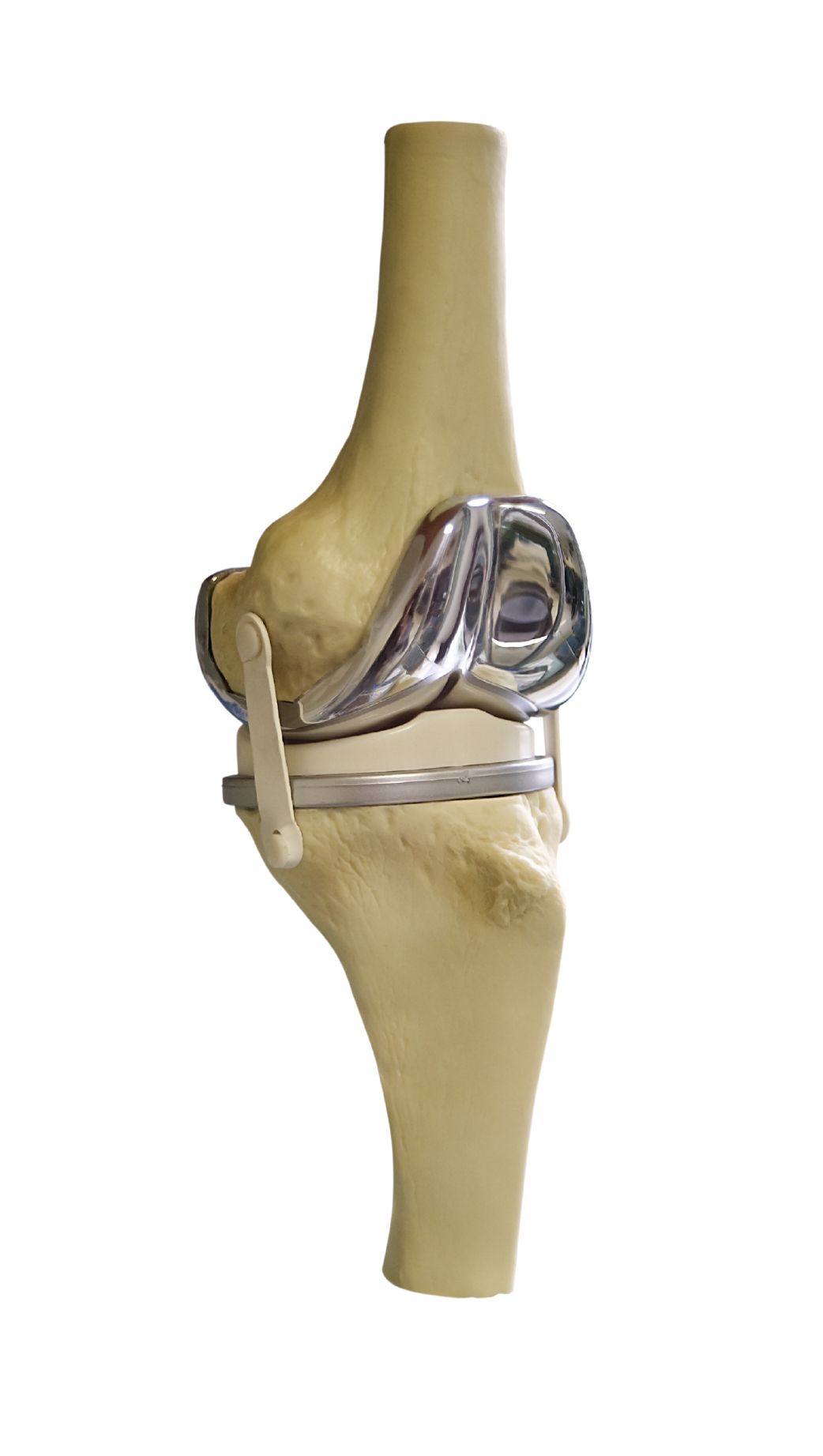What to Expect After Knee Replacement Surgery
The following guidelines will discuss precautions to protect your new knee joint, exercises to increase your knee strength and range of motion, and techniques to manage activities of daily living to help you become an active partner in your care and recovery.
Normal Knee Joint

Your knee is a hinge joint found where the end of the thigh bone (femur) meets the beginning of the large bone in your lower leg (tibia). A healthy knee has layers of smooth cartilage that cover the ends of the femur and the tibia. The smooth cartilage acts as a cushion and allows the surfaces of the two bones to glide smoothly as you bend your knee. The muscles and ligaments around the knee joint support your weight and help move the joint smoothly so you can walk without pain.
As the knee joint degenerates, the smooth cartilage can wear down on the ends of the femur and the tibia. The smooth surfaces become rough, like sandpaper. Instead of gliding smoothly when you bend your knee, the bones grind and you have pain and/or stiffness.
Your Replacement Knee Prosthesis
To create a new knee joint, the ends of the bones forming the joint are surgically removed. They are replaced with parts similar to pieces shown here. The parts of the prosthesis are made of metal and very strong plastic. The prosthesis provides new smooth surfaces on the ends of the bones.
Guidelines for Your New Knee Joint
Safety Tips for Home
- Use handrails on steps.
- Wear low-heeled or flat shoes.
- Avoid wet or waxed floors.
- Keep your floors free of items you could trip on. Throw rugs or small objects should be kept off the floor for your safety.
- Watch for pets or other animals that could get in your way.
- Avoid ice or snow.
Resting & Sleeping
When you are resting, you should have two pillows under your calf, not behind your knee or heel. Keeping your knee straight and elevated will help decrease swelling and improve range of motion. Sleeping on your stomach or on the side with your new knee will be uncomfortable and should be avoided for several weeks after surgery.
Blood Clots
Follow your orthopaedic surgeon's instructions carefully to minimize the potential of blood clots, which can occur during the first several weeks of your recovery.
Warning signs of possible blood clots in your leg:
- Increasing pain in your calf
- Tenderness or redness above or below your knee
- Increasing swelling in your calf, ankle, and foot
Warning signs that a blood clot has traveled to your lung:
- Sudden increase in shortness of breath
- Sudden onset of chest pain
- Localized chest pain with coughing
Notify your doctor immediately if you develop any of these signs.
Infection
The most common causes of infection following total knee replacement surgery are from bacteria that enter the bloodstream during the following:
- Dental procedures
- Urinary tract infections
- Skin infections
These bacteria can lodge around your knee replacement and cause an infection.
Once you are past 12 weeks from surgery, you may stop taking your antibiotics unless you fall under the following high-risk categories:
- Uncontrolled diabetes (A1C >8, glucose > 200)
- Compromised immune system
- HIV/AIDS
- Rheumatoid arthritis or patients on oral steroids
- Active cancer
- Prior organ transplant or bone marrow transplant
- History of periprosthetic or deep prosthetic joint infection
What Not to Do After Knee Replacement
-
Driving
-
Heavy lifting
-
Sitting on low or soft seats
You will need to avoid these activities for the long-term:
-
High-impact sports
-
Jogging
-
Running
How to Break Up Scar Tissue After Knee Replacement
You’ll develop scar tissue around the joint as your knee heals. Too much scar tissue can limit your range of motion. Following your physical therapist’s treatment plan is the best way to break up scar tissue and prevent excess build-up.
Recovery for the First Three Months
If you're knee is feeling good and you feel ready, you can return to all your usual activities after six weeks, except for high-impact activities such as running or jumping. You’ll need to avoid high-impact activities for the rest of your life to prolong the longevity of your new knee joint. Kneeling may be difficult, but it won’t damage the new joint. You will have yearly follow-up appointments for the rest of your life, where we will take knee X-rays.
How Long After Knee Replacement Can You Drive?
Most patients can drive in about 2–3 weeks after surgery. You may resume driving under the following conditions:
- You are not taking narcotic pain medications.
- You don't have leg spasms.
- You have full control of your leg.
Can You Run After Knee Replacement?
You should not run after a knee replacement. Running puts extra stress on your knee joints, which can cause the replacement to wear out more quickly. Your surgeon will likely recommend low-impact exercise, such as walking, hiking, biking, or swimming instead.
Lifetime Restrictions After Knee Replacement Surgery
It’s important to understand that you’ll need to modify your activities after a knee replacement to help the replacement last.
You’ll need to avoid certain activities for the rest of your life after a knee replacement:
-
Excessive stretching
-
High-impact sports
-
Jogging
-
Jumping
-
Running
You should also take antibiotics when getting dental work or other surgical procedures for the rest of your life if you have a high risk of infection. This lowers your risk of developing a joint replacement infection.





